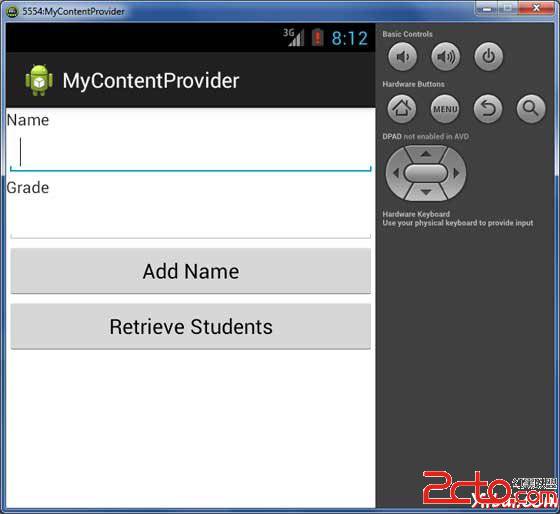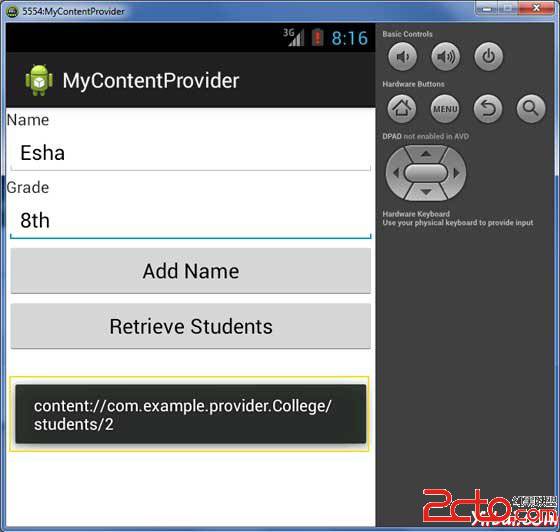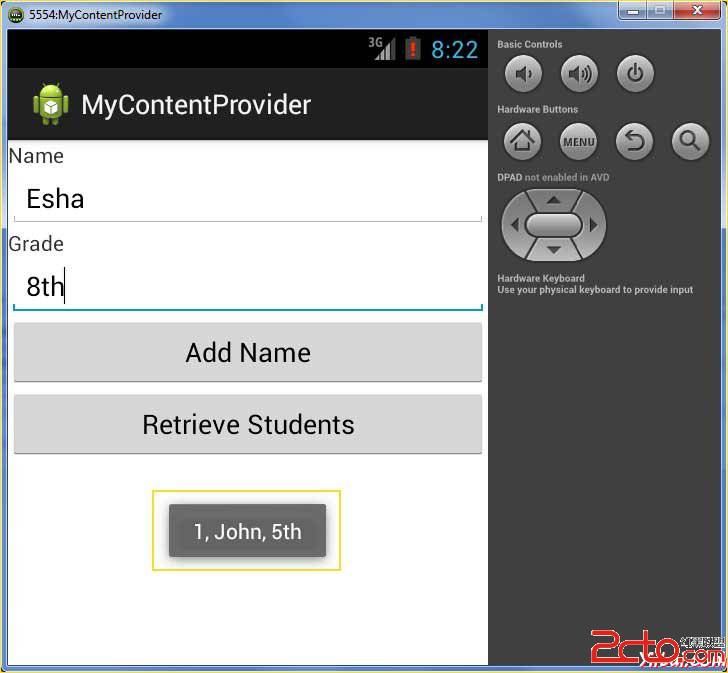編輯:高級開發
每一個 Android 應用程序運行在自己的進程保持一個應用程序數據,在另外一個應用程序中隱藏自己的權限。但有時需要在應用程序之間共享數據。這時內容提供程序是非常有用。
內容提供程序將內容集中在一個地方,讓許多不同的應用訪問。內容提供程序的行非常像數據庫,可以對它進行查詢,編輯等操作,添加或刪除可使用 insert(), update(), delete(), query() 方法。在大多數情況下,這些數據都存儲在SQlite數據庫。
內容提供程序實施 ContentProvider 類的子類,必須實現了一套標准的 API,使其他應用程序來執行事務。
public class MyContentProvider extends ContentProvider { }
要查詢內容提供程序,可以指定 URI 形式如以下格式的查詢字符串:
<prefix>://<authority>/<data_type>/<id>
這裡是URI的各個部分的細節
以下是簡單的步驟用來創建自己的內容提供者的數量。
首先,需要創建一個內容提供者擴展 ContentProvider 基類。
其次,需要定義內容提供者用於訪問內容的 URI 地址。
接下來,需要創建自己的數據庫用於保存內容。通常情況下,Android使用SQLite數據庫,並且框架需要重寫 onCreate() 方法會使用 SQLite開放的 Helper方法來創建或打開提供者數據庫。當啟動應用程序時,每個內容提供者的onCreate()方法調用處理程序在主應用程序。
接下來,必須實現內容提供者查詢來執行不同的數據庫的具體操作。
最後,在activity文件使用<provider>標簽注冊內容提供者。
下面是需要覆蓋內容提供程序類的方法的列表:
onCreate() 方法被稱為提供者開始。
query() 方法接收來自客戶端的請求。返回的結果作為一個Cursor對象。
insert() 方法插入一條新記錄到內容提供者。
delete() 方法從內容提供者刪除記錄。
update() 方法從內容提供者更新現有記錄。
getType() 此方法在給定的URI返回 MIME 類型的數據。
這個例子將解釋如何創建自己的 ContentProvider。因此按照下面的步驟類似於我們之前創建Hello World范例:
以下是主活動文件 src/com.example.mycontentprovider/MainActivity.java 修改後的內容。這個文件可以包括每個生命周期方法。我們已經增加了兩個新方法onClickAddName() 和onClickRetrieveStudents() 來處理用戶與應用程序交互。
package com.example.mycontentprovider; import android.net.Uri; import android.os.Bundle; import android.app.Activity; import android.content.ContentValues; import android.content.CursorLoader; import android.database.Cursor; import android.view.Menu; import android.view.View; import android.widget.EditText; import android.widget.Toast; public class MainActivity extends Activity { @Override protected void onCreate(Bundle savedInstanceState) { super.onCreate(savedInstanceState); setContentView(R.layout.activity_main); } @Override public boolean onCreateOptionsMenu(Menu menu) { getMenuInflater().inflate(R.menu.main, menu); return true; } public void onClickAddName(View view) { // Add a new student record ContentValues values = new ContentValues(); values.put(StudentsProvider.NAME, ((EditText)findViewById(R.id.txtName)).getText().toString()); values.put(StudentsProvider.GRADE, ((EditText)findViewById(R.id.txtGrade)).getText().toString()); Uri uri = getContentResolver().insert( StudentsProvider.CONTENT_URI, values); Toast.makeText(getBaseContext(), uri.toString(), Toast.LENGTH_LONG).show(); } public void onClickRetrieveStudents(View view) { // Retrieve student records String URL = "content://com.example.provider.College/students"; Uri students = Uri.parse(URL); Cursor c = managedQuery(students, null, null, null, "name"); if (c.moveToFirst()) { do{ Toast.makeText(this, c.getString(c.getColumnIndex(StudentsProvider._ID)) + ", " + c.getString(c.getColumnIndex( StudentsProvider.NAME)) + ", " + c.getString(c.getColumnIndex( StudentsProvider.GRADE)), Toast.LENGTH_SHORT).show(); } while (c.moveToNext()); } } }
在 com.example.mycontentprovider 包下創建新的 StudentsProvider.java 文件,以下是內容:
package com.example.mycontentprovider; import java.util.HashMap; import android.content.ContentProvider; import android.content.ContentUris; import android.content.ContentValues; import android.content.Context; import android.content.UriMatcher; import android.database.Cursor; import android.database.SQLException; import android.database.sqlite.SQLiteDatabase; import android.database.sqlite.SQLiteOpenHelper; import android.database.sqlite.SQLiteQueryBuilder; import android.net.Uri; import android.text.TextUtils; public class StudentsProvider extends ContentProvider { static final String PROVIDER_NAME = "com.example.provider.College"; static final String URL = "content://" + PROVIDER_NAME + "/students"; static final Uri CONTENT_URI = Uri.parse(URL); static final String _ID = "_id"; static final String NAME = "name"; static final String GRADE = "grade"; private static HashMap<String, String> STUDENTS_PROJECTION_MAP; static final int STUDENTS = 1; static final int STUDENT_ID = 2; static final UriMatcher uriMatcher; static{ uriMatcher = new UriMatcher(UriMatcher.NO_MATCH); uriMatcher.addURI(PROVIDER_NAME, "students", STUDENTS); uriMatcher.addURI(PROVIDER_NAME, "students/#", STUDENT_ID); } /**
* Database specific constant declarations
*/ private SQLiteDatabase db; static final String DATABASE_NAME = "College"; static final String STUDENTS_TABLE_NAME = "students"; static final int DATABASE_VERSION = 1; static final String CREATE_DB_TABLE = " CREATE TABLE " + STUDENTS_TABLE_NAME + " (_id INTEGER PRIMARY KEY AUTOINCREMENT, " + " name TEXT NOT NULL, " + " grade TEXT NOT NULL);"; /**
* Helper class that actually creates and manages
* the provider's underlying data repository.
*/ private static class DatabaseHelper extends SQLiteOpenHelper { DatabaseHelper(Context context){ super(context, DATABASE_NAME, null, DATABASE_VERSION); } @Override public void onCreate(SQLiteDatabase db) { db.execSQL(CREATE_DB_TABLE); } @Override public void onUpgrade(SQLiteDatabase db, int oldVersion, int newVersion) { db.execSQL("DROP TABLE IF EXISTS " + STUDENTS_TABLE_NAME); onCreate(db); } } @Override public boolean onCreate() { Context context = getContext(); DatabaseHelper dbHelper = new DatabaseHelper(context); /**
* Create a write able database which will trigger its
* creation if it doesn't already exist.
*/ db = dbHelper.getWritableDatabase(); return (db == null)? false:true; } @Override public Uri insert(Uri uri, ContentValues values) { /**
* Add a new student record
*/ long rowID = db.insert( STUDENTS_TABLE_NAME, "", values); /**
* If record is added successfully
*/ if (rowID > 0) { Uri _uri = ContentUris.withAppendedId(CONTENT_URI, rowID); getContext().getContentResolver().notifyChange(_uri, null); return _uri; } throw new SQLException("Failed to add a record into " + uri); } @Override public Cursor query(Uri uri, String[] projection, String selection, String[] selectionArgs, String sortOrder) { SQLiteQueryBuilder qb = new SQLiteQueryBuilder(); qb.setTables(STUDENTS_TABLE_NAME); switch (uriMatcher.match(uri)) { case STUDENTS: qb.setProjectionMap(STUDENTS_PROJECTION_MAP); break; case STUDENT_ID: qb.appendWhere( _ID + "=" + uri.getPathSegments().get(1)); break; default: throw new IllegalArgumentException("Unknown URI " + uri); } if (sortOrder == null || sortOrder == ""){ /**
* By default sort on student names
*/ sortOrder = NAME; } Cursor c = qb.query(db, projection, selection, selectionArgs, null, null, sortOrder); /**
* register to watch a content URI for changes
*/ c.setNotificationUri(getContext().getContentResolver(), uri); return c; } @Override public int delete(Uri uri, String selection, String[] selectionArgs) { int count = 0; switch (uriMatcher.match(uri)){ case STUDENTS: count = db.delete(STUDENTS_TABLE_NAME, selection, selectionArgs); break; case STUDENT_ID: String id = uri.getPathSegments().get(1); count = db.delete( STUDENTS_TABLE_NAME, _ID + " = " + id + (!TextUtils.isEmpty(selection) ? " AND (" + selection + ')' : ""), selectionArgs); break; default: throw new IllegalArgumentException("Unknown URI " + uri); } getContext().getContentResolver().notifyChange(uri, null); return count; } @Override public int update(Uri uri, ContentValues values, String selection, String[] selectionArgs) { int count = 0; switch (uriMatcher.match(uri)){ case STUDENTS: count = db.update(STUDENTS_TABLE_NAME, values, selection, selectionArgs); break; case STUDENT_ID: count = db.update(STUDENTS_TABLE_NAME, values, _ID + " = " + uri.getPathSegments().get(1) + (!TextUtils.isEmpty(selection) ? " AND (" + selection + ')' : ""), selectionArgs); break; default: throw new IllegalArgumentException("Unknown URI " + uri ); } getContext().getContentResolver().notifyChange(uri, null); return count; } @Override public String getType(Uri uri) { switch (uriMatcher.match(uri)){ /**
* Get all student records
*/ case STUDENTS: return "vnd.android.cursor.dir/vnd.example.students"; /**
* Get a particular student
*/ case STUDENT_ID: return "vnd.android.cursor.item/vnd.example.students"; default: throw new IllegalArgumentException("Unsupported URI: " + uri); } } }
以下將 AndroidManifest.xml 文件的內容修改。在這裡添加了<provider.../>標簽,包括內容提供者:
<?xml version="1.0" encoding="utf-8"?> <manifest xmlns:android="http://schemas.android.com/apk/res/android" package="com.example.mycontentprovider" android:versionCode="1" android:versionName="1.0" > <uses-sdk android:minSdkVersion="8" android:targetSdkVersion="17" /> <application android:allowBackup="true" android:icon="@drawable/ic_launcher" android:label="@string/app_name" android:theme="@style/AppTheme" > <activity android:name="com.example.mycontentprovider.MainActivity" android:label="@string/app_name" > <intent-filter> <action android:name="android.intent.action.MAIN" /> <category android:name="android.intent.category.LAUNCHER" /> </intent-filter> </activity> <provider android:name="StudentsProvider" android:authorities="com.example.provider.College"> </provider> </application> </manifest>
以下將 res/layout/activity_main.xml 文件的內容包括一個按鈕來自定義廣播意圖:


<LinearLayout xmlns:android="http://schemas.android.com/apk/res/android" android:layout_width="fill_parent" android:layout_height="fill_parent" android:orientation="vertical" > <TextView android:layout_width="fill_parent" android:layout_height="wrap_content" android:text="Name" /> <EditText android:id="@+id/txtName" android:layout_height="wrap_content" android:layout_width="fill_parent" /> <TextView android:layout_width="fill_parent" android:layout_height="wrap_content" android:text="Grade" /> <EditText android:id="@+id/txtGrade" android:layout_height="wrap_content" android:layout_width="fill_parent" /> <Button android:text="Add Name" android:id="@+id/btnAdd" android:layout_width="fill_parent" android:layout_height="wrap_content" android:onClick="onClickAddName" /> <Button android:text="Retrieve Students" android:id="@+id/btnRetrieve" android:layout_width="fill_parent" android:layout_height="wrap_content" android:onClick="onClickRetrieveStudents" /> </LinearLayout>
確保 res/values/strings.xml 文件有以下內容:
<?xml version="1.0" encoding="utf-8"?> <resources> <string name="app_name">MyContentProvider</string> <string name="action_settings">Settings</string> <string name="hello_world">Hello world!</string> </resources>;
現在運行剛剛創建的應用程序 MyContentProvider。假設設置AVD並且已經做好了環境設置。要從Eclipse運行的應用程序,從工具欄打開一個項目的活動文件,並單擊“Run”  圖標。Eclipse AVD 安裝的應用程序後並啟動它,如果設置和應用程序沒有問題,它會啟動顯示仿真器窗口(要耐心,可能有點慢,由你計算機的速度決定):
圖標。Eclipse AVD 安裝的應用程序後並啟動它,如果設置和應用程序沒有問題,它會啟動顯示仿真器窗口(要耐心,可能有點慢,由你計算機的速度決定):

現在輸入學生姓名和年級,最後單擊“Add Name”按鈕,將增加學生記錄到數據庫中,ContentProvider URI也一起添加到數據庫中,底部顯示的記錄數,並會閃爍一條消息。此操作使得我們的insert()方法的使用。讓我們重復這個過程,我們的內容提供者在數據庫中添加一些更多的學生信息。

正在添加記錄在數據庫中,現在其時間讓ContentProvider來給我們這些記錄回,所以讓我們的單擊檢索學生按鈕,這將獲取並顯示所有記錄這是按照我們執行query()方法。

可以編寫活動 MainActivity.java文件提供的回調函數,然後修改用戶界面,更新和刪除操作按鈕添加和讀操作以同樣的方式,因為我們已經做了更新和刪除操作。
通過這種方式,可以使用現有的內容提供者,如地址簿,或不錯的面向數據庫應用開發,可以使用內容提供者的概念,可以執行所有的數據庫操作,如排序讀,寫,更新和刪除上面的例子中解釋.
 .NET for Android將至 可移植Win Phone應用程序
.NET for Android將至 可移植Win Phone應用程序
繼PHP for android實現之後,微軟.Net for android,也就是MonoDroid,也將馬上進入Beta測試階段,最終的MonoDroid產品將在
 Android用戶界面OmniGraffle設計模板及下載
Android用戶界面OmniGraffle設計模板及下載
我們已經介紹了android用戶界面設計模板Dashboard,其實在Dashboard上Andriod用戶界面設計所制作的最初版本為OmniGraffle模板,現在已
 淺析Android DDMS性能問題
淺析Android DDMS性能問題
學習android DDMS時,經常會遇到android DDMS問題,這裡將介紹android DDMS問題的解決方法。Android DDMS有很多值得學習的地方,
 全面解讀Google Android手機操作系統
全面解讀Google Android手機操作系統
2010年Google android手機操作系統的最大臂助非HTC莫屬,我們來首先來回顧下android的發展歷程。 2008 年 10 月HTC推出了全球首款and